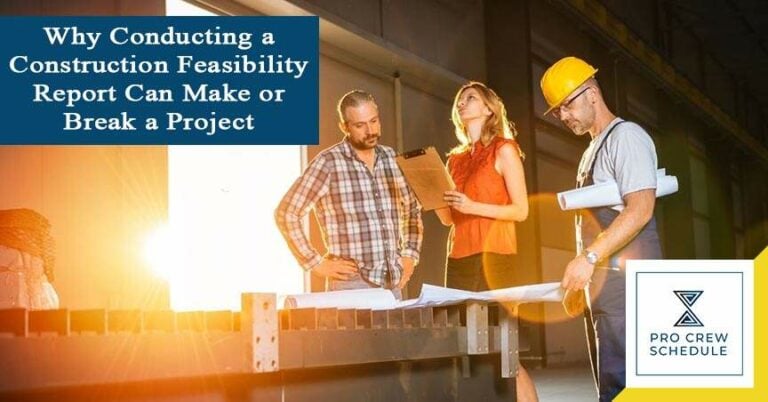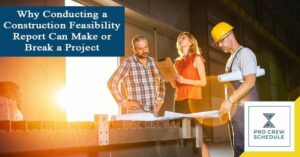Like all project management plans across different industries, project management for construction involves a predetermined process that starts with project initiation and ends with completion and delivery. Typically, the first significant step is to perform a feasibility study or report, which belongs in the planning phase. For some construction firms, the planning phase is involved in the preconstruction phase.
In managing construction, the role of the beginning steps and making the most of it cannot be overstated enough. Organized and detailed planning will do a project; messy and unprepared planning will break it.
Why is Conducting a Feasibility Important in Construction?
An accurate construction feasibility study can help you see the whole perspective early on so you can work from a top to down approach when planning. An effective feasibility report will guide you on whether it is smart to proceed with an idea, revise it, or even scrap it altogether.
When conducting a feasibility report, you will need to break down the most general questions into numerous, narrower, and more detailed questions to bring you closer to the ultimate solution to the problem. This study will move you to take action and ask questions to ensure whether a project thought, idea or plan is likely to succeed. For instance, asking whether installing a new HVAC system will improve the efficiency and safety of your mechanical system and ultimately lower your utility expenses is an excellent place to start.
In a nutshell, a construction feasibility study helps you to get it right the first time, even before you commit a huge some of the time, money, and resources towards building a project. Plumbing, mechanical, and electrical systems are not cheap, and coming back later to remove limitations and correct flaws that were not anticipated can be very costly.
What is the Goal of a Project Feasibility Study?
As discussed above, a feasibility study helps general contractors and project owners determine whether a construction project is feasible. Regardless of the answer, a feasibility study will surely provide you with concrete data that explains the basis for its conclusion.
Moreover, it will also ensure that the project remains feasible, which will for the needed documents such as the strategic brief and execution plan.
On more extensive and more complex projects, it’s not uncommon for construction firms to conduct multiple project feasibility assessments related to various aspects of the work, including:
- Environmental risks
- Limitation of client’s budget
- Possible design issues that can affect maintenance
- Requirements for legal and regulatory approval
- Construction crew management
- Procurement and inventory procedure
Given the all-around nature of a construction feasibility assessment, it’s not surprising for many project stakeholders and even third-party personnel such as regulators to be involved in the evaluation.
As such, when you conduct a feasibility study for a project, it’s obligatory to have an excellent working knowledge of the construction industry’s many moving parts.
What Does a Project Feasibility Study Look At?
1. Scheduling Feasibility
This step considers the big picture of the project and whether it’s feasible to finish the project within the client’s timeframe. Can the project be executed and delivered to the client’s—and the team’s—expectations concerning timing?
Scheduling feasibility estimates how much time the project will take to be completed. This assessment is vital to the success of a project, especially if it involves a structure that is already occupied. After all, a project that failed to be completed on time is a failed project.
2. Operational Feasibility
This assessment determines if — and how effectively — the project’s output meets the needs of the project owner. It also ensures that all the requirements and standards are completed satisfactorily as identified in the project planning phase.
3. Organizational Feasibility
This part of the feasibility study is concerned with whether every party involved in the construction project can complete it successfully. Even if a project involves just one general contractor, a construction manager needs to ensure that their workers are available and productive with their tasks.
Are all of the crew members involved—and there could be a cast of hundreds in significant and complex projects—capable of doing their jobs as described? The major starring roles as well as the supporting cast? Will the subcontractor’s crew and the suppliers be there when you need them?
This is where having an efficient and well-thought-out software centered around task management comes in handy.
4. Legal Feasibility
A legal feasibility study analyses the project’s compliance with building codes and legal requirements. Some of the legal requirements to delve into are environmental regulations and zoning laws. The goal is to uncover if any part of the project conflicts with existing rules and laws.
When conducting a feasibility analysis for a construction project, you’ll also need to determine any potential legal hurdles. Any project will have at least some regulatory requirements to address, such as acquiring the correct permits and certifications.
These regulatory concerns can be overwhelming on big, complex projects, highlighting the importance of conducting a feasibility study to ensure they can be satisfied within the client’s desired timeframe.
5. Technological Feasibility
Many of the industry’s biggest trends are related to technological innovations. Then, it should come as no surprise that technological advancement plays a key role in construction project feasibility studies.
Resources, human factors, materials, skills with new construction software, and other elements should be considered. Is everything needed to bring a project to a successful completion readily available for the crew? And are the key players sufficiently experienced with using these resources and technology?
If this area presents a challenge for your organization, it should reflect in the conclusions of your feasibility study. Always keep in mind that larger construction projects may also come with the potential for incorporating entirely new technologies, such as construction management software. When a project involves such an undertaking, this should also be reflected in the feasibility report.
6. Economic Feasibility
The financial area of any project, no matter how big or small, must be looked at before executing the said project. This assessment is designed to help the project owner determine the cost, the benefits, and everything between the project.
Simply speaking, this is a cost/benefit analysis.
For commercial buildings, the economics step of the study asks the following: is it economically feasible? What are the strengths and risks of the project?
If it’s a residential building, can the person foot the bill payments quickly and consistently?
What are the Construction Hazards that Must Be Included in the Feasibility Report?
A well-planned and well-designed project feasibility study determines whether or not the project is viable, the site remediations that need to be made to complete the project, and if another location is more suited for the project.
Feasibility studies vary based on every project’s size, complexity, and circumstances; most reports include some combination of the following construction hazards.
1. Geologic Hazards
In order for your architectural and design team to develop the best possible plans for your site, it may be necessary to have a complete investigation of geologic hazards. The information collected can be used to mitigate any known potential issues and reduce future risks such as:
- Active faulting
- Fault rupture potential
- Expansive Soils
- Seismic hazards
- Slope stability problems
- Flooding and Inundation
- Potential earthquake magnitudes
- Ground accelerations
- Lateral Spreading and Slope Stability
- Liquefaction
- Subsidence and other risks
In your feasibility study, these potential risks should be analyzed and include recommendations made for proper mitigation or repair.
There are various methods used to identify geologic hazards that may include any of the following:
- Surface mapping
- Landslide investigation
- Boring samples for soil stability
- Geologic modeling of slope materials
- Installation of slope inclinometers
- Subsurface analysis
2. Hydrogeological Investigation
Hydrogeological conditions may impact your proposed building plans. An investigation that aims to evaluate the movement of groundwater through soil media below your proposed site location will help determine constructability given your groundwater conditions, monitoring output, and other needs.
Hydrogeological hazard studies determine groundwater conditions for the following:
- Design construction dewatering
- Water resource potential
- Assessment of hazards related to liquefaction potential and slope stability
3. Seismicity and Fault Studies
Evaluation of the on-site geologic conditions may be needed to mitigate the present potential hazards with concerns to seismic activity depending on the scope of work. This feasibility study may consider:
- Liquefaction potential
- Surface flooding potential for groundwater
- Soil stability risks (compressive, expansive, collapsible, and organic)
- Lateral spreading in seismic hazard zones susceptible to shaking
- Landslides, erosion, rock falls, and mudflows in relation to slope stability.
- Ground cracking and settlement in earthquake fault hazard zones.
Conclusion
When you examine all the areas and potential hazards in a construction project, you will be able to identify any possible constraints your property stands to face. In turn, you will be able to ensure timely completion, adherence to safety, zonal and environmental regulations, and so forth.
Manage construction projects with trusted tools and software that can help streamline your documentation, task delegation, crew scheduling, and overall collaboration with your stakeholders, and create a good feasibility analysis from day one. Start a 30-days free trial with Pro Crew Schedule today.







